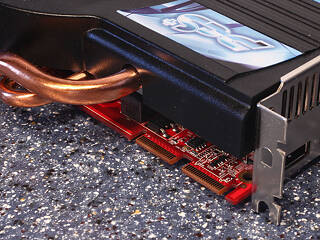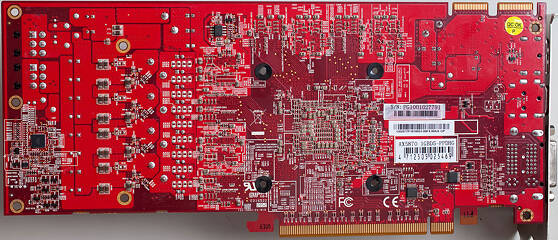 33
33
Powercolor HD 5870 PCS+ Review
A Closer Look »The Card
Powercolor's cooler is huge and covers the whole card. You can easily see where the heat pipes are located that help with the heat transfer. However, in my opinion, it can not compete with the looks of AMD's reference design cooler. It should also be noted that the heatpipes add quite a bit of size to the card, which could cause a problem with the side panels in some smaller cases.
Just like the reference design, the card occupies two slots in the system.
The card has two DVI ports, one HDMI port, and one DisplayPort. This is just one of many output configurations that are possible on the new cards, thanks to the overhauled display output logic. Basically the card can drive six TMDS signals that can be combined in any way (a dual-link DVI consumes two TMDS lines).
For HDMI Audio, NVIDIA requires you to feed an external audio source, for example from your motherboard's on-board audio, to the card via SPDIF cable. AMD on the other hand has integrated a sound device inside their GPUs which is the easier solution for most users. Also AMD's integrated sound device has been upgraded to support HDMI 1.3a which includes Dolby TrueHD, DTS-HD, AC-3, DTS and up to 7.1 channel audio with 192 kHz / 24-bit.
Crossfire configurations are supported to improve performance even further.
Here are the front and the back of the card, high-res versions are also available (front, back). If you choose to use these images for voltmods etc, please include a link back to this site or let us post your article.
Feb 21st, 2025 13:06 EST
change timezone
Latest GPU Drivers
New Forum Posts
- As we live the age of game remakes, which game you would like to see to have a remake? (300)
- B580 tanks performance with low end CPUs (160)
- Dune: Awakening benchmark - post your results (6)
- [GPU-Z] Asus ROG Astral RTX 5090 OC Bios reading not supported (3)
- It's happening again, melting 12v high pwr connectors (844)
- How to quickly & easily fix coil-whine(coil choke noise) (1126)
- AAF Optimus Modded Driver For Windows 10 & Windows 11 - Only for Realtek HDAUDIO Chips (328)
- wood workstation project (20)
- What are you playing? (22963)
- RTX 5080 Missing from vBIOS upload (4)
Popular Reviews
- MSI GeForce RTX 5070 Ti Ventus 3X OC Review
- Gigabyte GeForce RTX 5090 Gaming OC Review
- Galax GeForce RTX 5070 Ti 1-Click OC White Review
- ASUS GeForce RTX 5070 Ti TUF OC Review
- Ducky One X Inductive Keyboard Review
- MSI GeForce RTX 5070 Ti Vanguard SOC Review
- MSI GeForce RTX 5070 Ti Gaming Trio OC+ Review
- AMD Ryzen 7 9800X3D Review - The Best Gaming Processor
- MSI MAG Z890 Tomahawk Wi-Fi Review
- NVIDIA GeForce RTX 5080 Founders Edition Review
Controversial News Posts
- AMD Radeon 9070 XT Rumored to Outpace RTX 5070 Ti by Almost 15% (302)
- AMD Plans Aggressive Price Competition with Radeon RX 9000 Series (268)
- AMD is Taking Time with Radeon RX 9000 to Optimize Software and FSR 4 (256)
- AMD Radeon RX 9070 and 9070 XT Listed On Amazon - One Buyer Snags a Unit (247)
- Edward Snowden Lashes Out at NVIDIA Over GeForce RTX 50 Pricing And Value (241)
- AMD Denies Radeon RX 9070 XT $899 USD Starting Price Point Rumors (239)
- New Leak Reveals NVIDIA RTX 5080 Is Slower Than RTX 4090 (215)
- NVIDIA GeForce RTX 5090 Spotted with Missing ROPs, Performance Loss Confirmed, Multiple Vendors Affected (162)






